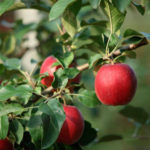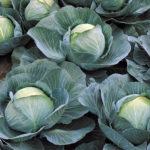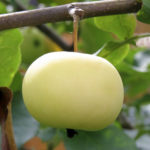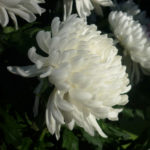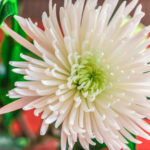Peony Rubra captivity (Rubra plena)
Peonies today can be seen in almost every flower garden. This is because these plants are generally unpretentious and very resistant to cold weather, and other negative environmental factors. We would like to bring to your attention information about the Rubra plona variety - one of the most popular varieties of the "king of flowers" today.
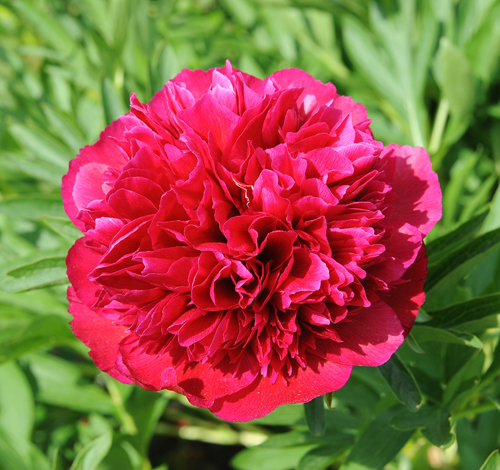
Description of the variety
The culture from the Peony family, which will be discussed, is not just an ornamental plant, but also a medicinal perennial. Otherwise it is called "ordinary peony". Also, when referring to this flower, the definition of "thin-leaved" is used.
Our hero belongs to herbaceous varieties and is a representative of the group of terry varieties. It is characterized by the presence of purple, dark cherry or ruby-red inflorescences about 15 cm in diameter with shiny petals. The shape of the opened Rubra plena bud is bomb-shaped or spherical. When you look at it, the association arises of a luxurious double flower with a bright pompom. Over time, the shade of the petals around the edges becomes lighter. Delicate buds smell nice: their enchanting aroma is very delicate, floral. Inflorescences appear on the culture quite early, in May, in the amount of 2-3 dozen, and delight their owner for 2-2.5 weeks. They do not fade in the sun and stay on the bush for a long time.
In addition to the attractive type of flowers on a strong, low (50−85 cm), spreading shrub, there are bright green, graceful, thinly dissected leaves, hence one of the names of the variety - “thin-leaved peony”. The plant is formed by thick, sometimes slightly curved shoots. The crown of the bush is compact. Although the stems of the crop are strong, it is still better for them to provide support during flowering.
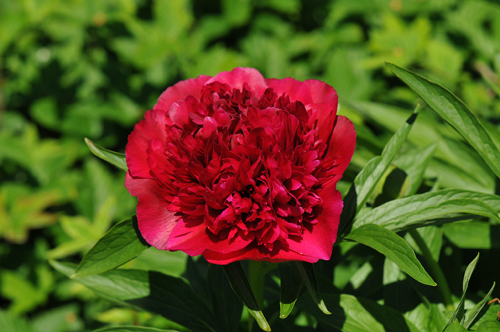
Rubra captivity is a winter-hardy plant that can withstand frosts down to -40 ° C. Damage to the crop by pests such as ants and aphids is rare, since the variety has good hardiness. He is also not afraid of temperature changes and lack of snow cover in winter. Rubra plena does not need shelter.
Features of agricultural technology
A handsome man with bright inflorescences grows best in sunny places. Light partial shade is important for him at midday in the summer. If you place the peony in the shade, it will either not bloom or its flowers will be very small. The neighborhood of culture with brick and stone buildings, trees with a spreading crown and large shrubs is not recommended. In the first case, overheating of the perennial is possible, in the second, the drops from the roof will destroy young shoots making their way through the soil in the spring, in the third, the flower will give moisture and nutrients to more impressive neighbors.
Any soil can be used for planting Rubra plena, but loam is the preferred option. In this case, the soil should have the following qualities: a high degree of fertility, increased moisture capacity, looseness. Sandy soils are completely unsuitable for the plant. The pH of the soil for perennial Rubra captivity should be slightly acidic.
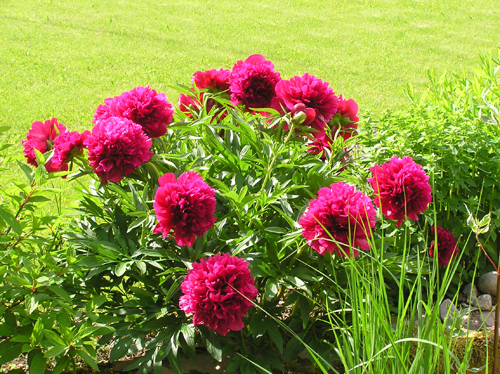
The shrubs are planted in a hole 60 cm deep and wide. It is filled with a soil mixture prepared from equal parts of humus, garden soil, peat, sand, as well as a small amount of wood ash and superphosphate. When deepening the seedling, make sure that the buds are at least 5 cm below the ground level. The distance from the peony to other plants should be about a meter.
It is easy to care for a herbaceous perennial. It needs to be watered and fed regularly. During the period of bud formation and in the flowering phase, the soil under the plant is moistened especially abundantly - up to 3 buckets of water per plant. In the spring, an organic fertilizer is applied under the flower, in the budding phase and in the fall, after the flowering of the bush - a mineral complex. He does not need feeding more than three times per season. Periodically, the soil is loosened and mulched to prevent the soil from drying out quickly. Before the onset of winter, the shrub is cut 5-7 cm above the soil level.
In conditions of prolonged damp weather or flooding of soil, gray rot may appear on the plant. In order to prevent this disease, the bush must be treated with copper sulfate and Bordeaux liquid a couple of times during the growing season. If your pet doesn't want to bloom, try thinning.
Use cases
The Rubra captivity variety can be placed in flower beds and gardens of any type. It looks impressive both in solitary plantings and in group compositions. The plant will decorate mixborders, rock gardens. Rubra plena shrubs are appropriate along the garden paths, near the gazebo. They go well with other flowering perennials: roses, lilies, clematis, hosts, phlox, irises. Since this is an early flowering culture, it should be planted in one composition with daffodils, tulips, crocuses, galanthus. It is good to place plantings of peonies of this variety along the fence. In addition, conifers of miniature sizes may well become companions of a healing handsome man. Fragrant inflorescences are great when cut. They stand in water for a long time without losing their freshness and flower petals.
Since we are dealing with a medicinal plant, it makes sense to mention its beneficial properties. All parts of the culture contain a large amount of essential oils, tannins, alkaloids, mineral salts, vitamins and bioflavonoids. In rhizomes, their concentration is slightly higher. Medicinal effects of the plant: bactericidal, anticonvulsant, sedative, antispasmodic, anti-inflammatory, tonic, anti-cancer. From peony thin-leaved Rubra captivity, alcohol tinctures are produced - both for ingestion and for external grinding; prepare teas and decoctions. Indications for the use of these drugs are insomnia, depression, metabolic disorders, allergies, neuroses and mental disorders, deterioration of the appearance of nails and hair, skin and heart problems, convulsions.

